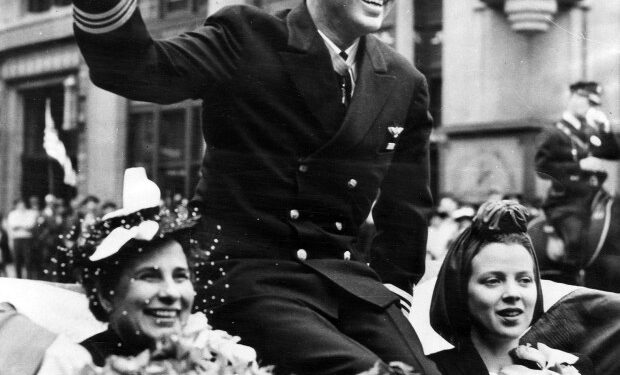Here’s a look back at what happened in the Chicago area on Feb. 20, according to the Tribune’s archives.
Is an important event missing from this date? Email us.
Weather records (from the National Weather Service, Chicago)
- High temperature: 70 degrees (2017)
- Low temperature: Minus 9 degrees (1896)
- Precipitation: 2.1 inches (2018)
- Snowfall: 2.8 inches (1989)
1852: The first direct train from the East arrived in Chicago to the sound of a firing cannon and the sight of an immense crowd on the Michigan Southern Railroad.

1942: U.S. Navy pilot Edward “Butch” O’Hare became a World War II hero when he singlehandedly downed a number of Japanese bombers attacking his aircraft carrier. This would make him the first naval aviator recipient of the Congressional Medal of Honor. In presenting the award, President Franklin D. Roosevelt referred to O’Hare’s skill as “the most daring single action in aviation history.” After being awarded the Medal of Honor, O’Hare was brought home by the Navy to barnstorm on a Lindbergh-style celebrity tour.
O’Hare was 29 when he died on Nov. 26, 1943 while leading the Navy’s first nighttime fighter attack launched from an aircraft carrier. His plane and his body were never recovered.
Other than through his father, mob-connected racetracker owner Edward J., O’Hare had only loose ties to Chicago. When his parents were divorced, he stayed in St. Louis with his mother, moving his family to Phoenix during the war. That was no deterrent to Tribune publisher Robert R. McCormick in his campaign to have Chicago’s Orchard Place Airport rechristened honor Butch O’Hare, and in 1949 Ald. John Hoellen’s proposal passed the City Council, creating O’Hare Field.

1958: Nathan Leopold, who was convicted with Richard Loeb of killing Bobby Franks in 1924, was released on parole.
Want more vintage Chicago?
Subscribe to the free Vintage Chicago Tribune newsletter, join our Chicagoland history Facebook group, stay current with Today in Chicago History and follow us on Instagram for more from Chicago’s past.
Have an idea for Vintage Chicago Tribune? Share it with Kori Rumore and Marianne Mather at krumore@chicagotribune.com and mmather@chicagotribune.com







